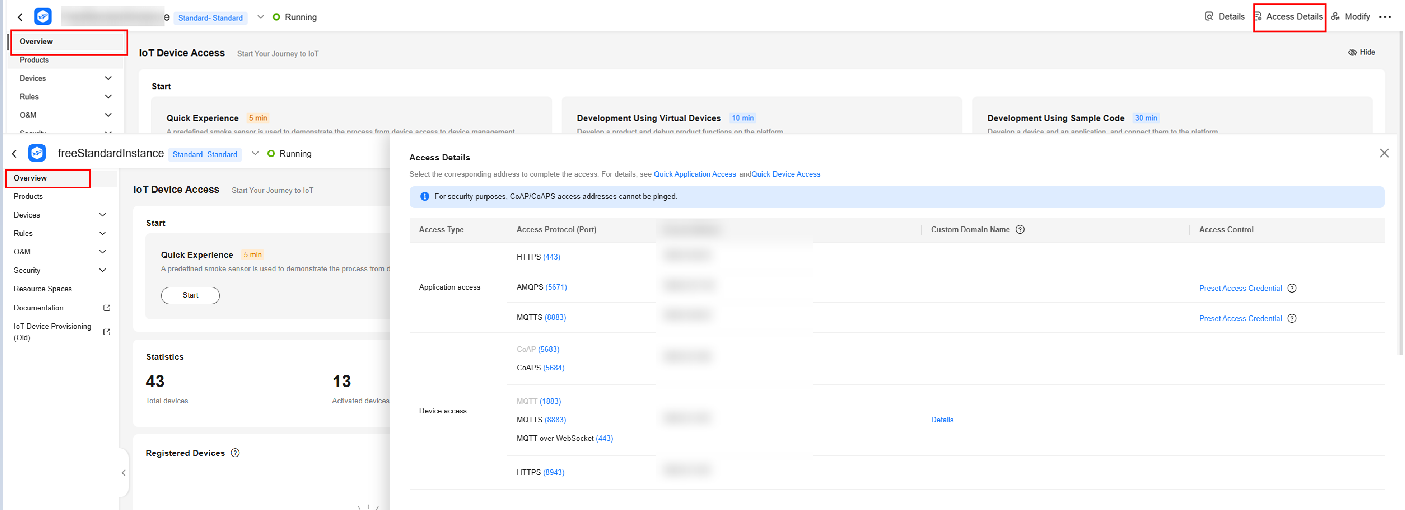Obtaining Resources
Platform Connection Information
- Log in to the IoTDA console. In the navigation pane, choose IoTDA Instances, and click the target instance card.
Figure 1 Instance management - Changing instance

- In the navigation pane, choose . In the Instance Information area, click Access Details.
Figure 2 Obtaining access information

Device Development Resources
You can connect devices to IoTDA using MQTT, LwM2M/CoAP, and HTTPS, as well as connect devices that use Modbus, OPC UA, and OPC DA through IoTEdge. You can also connect devices to IoTDA by calling APIs or integrating SDKs.
|
Resource Package |
Description |
Download Link |
|---|---|---|
|
IoT Device Java SDK |
Devices can connect to the platform by integrating the IoT Device Java SDK. The demo provides the sample code for calling SDK APIs. For details, see IoT Device Java SDK. |
|
|
IoT Device C SDK for Linux/Windows |
Devices can connect to the platform by integrating the IoT Device C SDK. The demo provides the sample code for calling SDK APIs. For details, see IoT Device C SDK. |
|
|
IoT Device C# SDK |
Devices can connect to the platform by integrating the IoT Device C# SDK. The demo provides the sample code for calling SDK APIs. For details, see IoT Device C# SDK. |
|
|
IoT Device Android SDK |
Devices can connect to the platform by integrating the IoT Device Android SDK. The demo provides the sample code for calling SDK APIs. For details, see IoT Device Android SDK. |
|
|
Device IoT Device Go SDK (Community Edition) |
Devices can connect to the platform by integrating the IoT Device Go SDK. The demo provides the code sample for calling the SDK APIs. For details, see IoT Device Go SDK. |
|
|
IoT Device Python SDK |
Devices can connect to the platform by integrating the IoT Device Python SDK. The demo provides the code sample for calling the SDK APIs. For details, see |
|
|
IoT Device Tiny C SDK for Linux/Windows |
Devices can connect to the platform by integrating the IoT Device Tiny C SDK. The demo provides the sample code for calling SDK APIs. For details, see IoT Device Tiny C SDK for Linux/Windows. |
|
|
IoT Device ArkTS (OpenHarmony) SDK |
Devices can connect to the platform by integrating the IoT Device ArkTS SDK. The demo provides the code sample for calling the SDK APIs. For details, see |
|
|
Native MQTT or MQTTS access |
Devices can be connected to the platform using the native MQTT or MQTTS protocol. The demo provides the sample code for SSL-encrypted link setup, TCP link setup, data reporting, and topic subscription. |
|
|
Product model template |
Product model templates of typical scenarios are provided. You can customize product models based on the templates. For details, see Developing a Product Model Offline. |
|
|
Codec example |
Demo codec projects are provided for you to perform secondary development. |
|
|
Codec test tool |
The tool is used to check whether the codec developed offline is normal. |
|
|
NB-IoT device simulator |
The tool is used to simulate the access of NB-IoT devices to the platform using LwM2M over CoAP for data reporting and command delivery. For details, see Connecting and Debugging an NB-IoT Device Simulator. |
Application Development Resources
The platform provides a wealth of application-side APIs to ease application development. Applications can call these APIs to implement services such as secure access, device management, data collection, and command delivery.
|
Resource Package |
Description |
Download Link |
|---|---|---|
|
Application API Java Demo |
You can call application-side APIs to experience service functions and service processes. |
|
|
Application Java SDK |
You can use Java methods to call application-side APIs to communicate with the platform. For details, see Java SDK. |
|
|
Application .NET SDK |
You can use .NET methods to call application-side APIs to communicate with the platform. For details, see .NET SDK. |
|
|
Application Python SDK |
You can use Python methods to call application-side APIs to communicate with the platform. For details, see Python SDK. |
|
|
Application Go SDK |
You can use Go methods to call application-side APIs to communicate with the platform. For details, see Go SDK. |
|
|
Application Node.js SDK |
You can use Node.js methods to call application-side APIs to communicate with the platform. For details, see Node.js SDK. |
|
|
Application PHP SDK |
You can use PHP methods to call application-side APIs to communicate with the platform. For details, see PHP SDK. |
Certificates
The following certificates are used when devices and applications need to verify IoTDA.

- The certificates apply only to Huawei Cloud IoTDA and must be used together with the corresponding domain name.
- CA certificates can no longer be used to verify server certificates upon expiration. Replace CA certificates before they expire to ensure that devices can connect to the IoT platform properly.
|
Certificate Package Name |
Region and Edition |
Certificate Type |
Certificate Format |
Description |
Download Link |
|---|---|---|---|---|---|
|
certificate |
CN-Hong Kong, AP-Singapore, AP-Bangkok, AP-Jakarta, AF-Johannesburg, LA-Santiago, LA-Sao Paulo1, LA-Mexico City2, and ME-Riyadh |
Device certificate |
pem, jks, and bks |
Used by a device to verify the platform identity. The certificate must be used together with the device access domain name. |
|
|
certificate |
CN-Hong Kong, AP-Singapore, AP-Bangkok, AP-Jakarta, AF-Johannesburg, LA-Santiago, LA-Sao Paulo1, LA-Mexico City2, and ME-Riyadh |
Application certificate |
pem, jks, and bks |
Application access: HTTPS/AMQPS/MQTTS platform CA certificates |
Feedback
Was this page helpful?
Provide feedbackThank you very much for your feedback. We will continue working to improve the documentation.See the reply and handling status in My Cloud VOC.
For any further questions, feel free to contact us through the chatbot.
Chatbot





